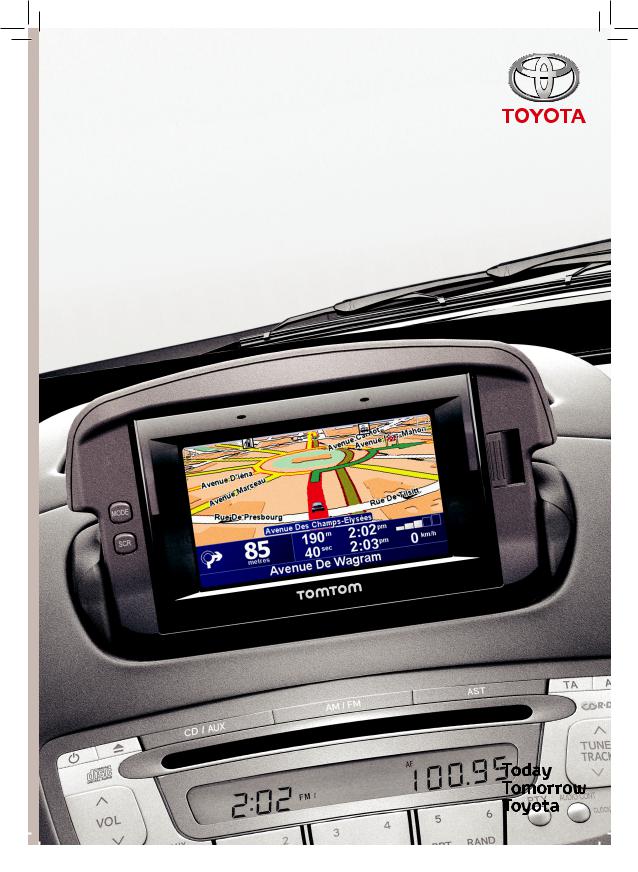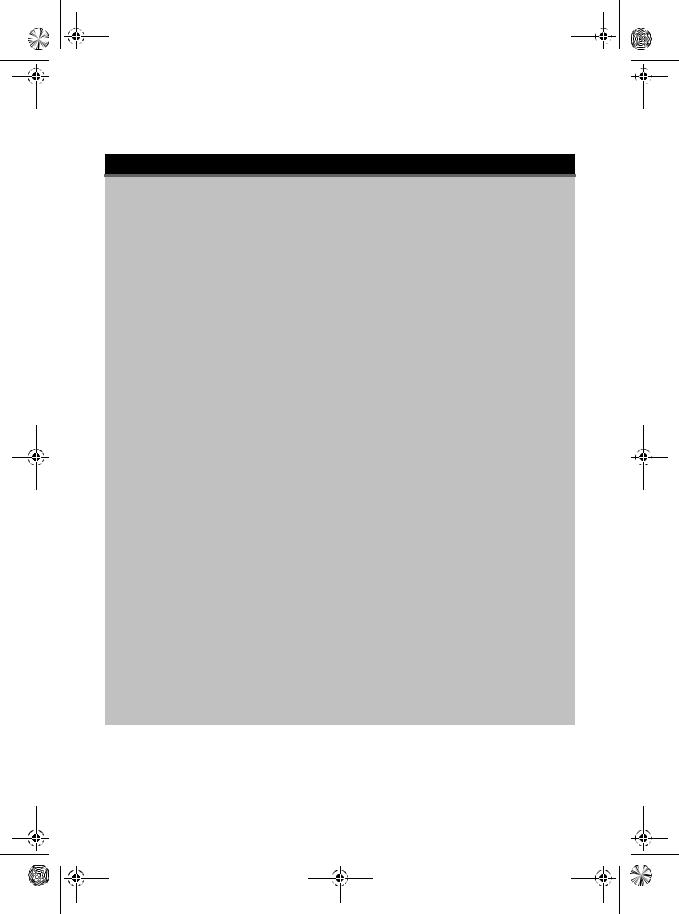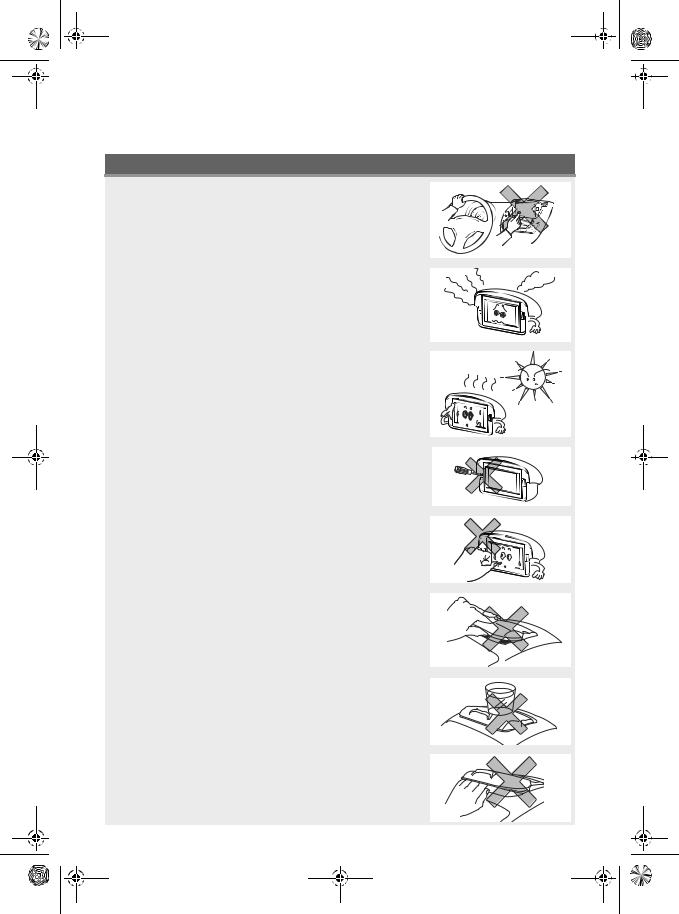Toyota AYGO - S Owner's Manual

ToyotaAygoConnectMultimedia
Owners manual
|
|
|
|
|
|
|
|
|
|
|
|
|
|
|
|
|
|
|
|
|
|
|
|
|
|
|
|
|
TACM2010_Cover_EN.indd 5 |
10/1/10 6:32 PM |
|
|
|
|
|
|
|
|
|
|
|
|
|
|
|
|
|

TACM2010_EN.book Page 1 Tuesday, October 5, 2010 3:44 PM
|
TABLE OF CONTENTS |
1 |
Table of Contents |
|
|
Before Use |
|
|
1. |
Introduction .................................................................................. |
4 |
2. |
Safety Instruction......................................................................... |
5 |
3. |
Warnings....................................................................................... |
6 |
|
Limitations of the navigation system .................................................... |
6 |
4. |
Safety precautions....................................................................... |
7 |
5. |
Before use .................................................................................... |
9 |
Operation |
|
|
1. |
About This Receiver .................................................................. |
10 |
|
Control Names and Operations .......................................................... |
10 |
|
Panel Switches .................................................................................. |
10 |
|
Turning the POWER ON or OFF ......................................................... |
11 |
|
Power ON .......................................................................................... |
11 |
|
Power OFF......................................................................................... |
11 |
|
Switching Between the Audio and Navigation Screen..................... |
11 |
|
Turning the PND Display ON and OFF............................................... |
11 |
|
Open and Close the device ................................................................. |
11 |
|
Detaching/Attaching the PND ............................................................. |
12 |
|
Using the PND ................................................................................... |
12 |
|
How to Detach the PND from the Main Unit ...................................... |
12 |
|
Attaching the PND ............................................................................. |
12 |
|
Hands-Free Microphone and Light Sensor........................................ |
13 |
|
Operation Conditions of this Receiver .............................................. |
13 |

TACM2010_EN.book Page 2 Tuesday, October 5, 2010 3:44 PM
2 |
TABLE OF CONTENTS |
|
|
2. Using TomTom Navigation........................................................ |
14 |
|
Before you start ................................................................................... |
14 |
|
Switching on....................................................................................... |
14 |
|
Setting up........................................................................................... |
14 |
|
Troubleshooting ................................................................................. |
14 |
|
Improving reception ........................................................................... |
15 |
|
Take care of your TomTom................................................................ |
15 |
|
Light sensor ....................................................................................... |
15 |
|
Making your first journey .................................................................... |
16 |
|
Driving View ......................................................................................... |
18 |
|
Main menu ......................................................................................... |
18 |
|
TomTom Traffic.................................................................................... |
19 |
|
Introducing TomTom HOME ............................................................... |
19 |
|
Installing TomTom HOME.................................................................. |
19 |
|
MyTomTom Account.......................................................................... |
20 |
|
Discover more ...................................................................................... |
20 |
|
TomTom Map ShareTM ...................................................................... |
20 |
|
Help me!............................................................................................. |
20 |
|
Hands-free calling .............................................................................. |
20 |
|
Safety preferences............................................................................. |
20 |

TACM2010_EN.book Page 3 Tuesday, October 5, 2010 3:44 PM
TABLE OF CONTENTS |
3 |
Audio Operations |
|
1. Using the USB Music File Player.............................................. |
21 |
Playing USB Music Files ..................................................................... |
21 |
Connecting USB to USB connector and disconnecting |
|
USB from USB connector .................................................................. |
21 |
Selecting a Desired Music File ........................................................... |
22 |
Finding a Desired Music File .............................................................. |
22 |
Repeatedly Playing the Same Music File........................................... |
23 |
Random Play of Music Files ............................................................... |
23 |
About USB devices.............................................................................. |
24 |
Playable USB Memory Standards ..................................................... |
24 |
Playable MP3 File Standards............................................................. |
24 |
ID3 Tags ............................................................................................ |
24 |
Format of USB Memory ..................................................................... |
24 |
How to operate portable audio devices |
|
1. Using the iPod Player ................................................................ |
25 |
Listening to the iPod ........................................................................... |
25 |
Connecting iPod to iPod connector and disconnecting |
|
iPod from iPod connector................................................................... |
25 |
Selecting the Desired Music File ........................................................ |
26 |
Finding a Desired Music File .............................................................. |
26 |
About iPod software version .............................................................. |
27 |
Reference |
|
1. Troubleshoot .............................................................................. |
28 |
When You Think There Is a Malfunction............................................ |
28 |
2. Specifications............................................................................. |
30 |
3. PND Charging Information........................................................ |
30 |

TACM2010_EN.book Page 4 Tuesday, October 5, 2010 3:44 PM
4 |
BEFORE USE |
Introduction
Thank you for your purchase of the Navigation System. Please read this manual carefully to ensure proper use.
The Navigation System is one of the most technologically advanced vehicle accessories ever developed. The system receives satellite signals from the Global Positioning System (GPS) operated by the U.S. Department of Defense. Using these signals and other vehicle sensors, the system indicates your present position and assists in locating a desired destination.
The navigation system is designed to select efficient routes from your present starting location to your destination. The system is also designed to direct you to a destination that is unfamiliar to you in an efficient manner. Map database is made based on TomTom maps, whose information source comes from Tele Atlas maps. The calculated routes may not be the shortest nor the least traffic congested. Your own personal local knowledge or “short cut” may at times be faster than the calculated routes.
The system will provide both a visual map and audio instructions. The audio instructions will announce the distance remaining and the direction to turn in, approaching an intersection. These voice instructions will help you keep your eyes on the road and are timed to provide enough time to allow you to maneuver, change lanes or slow down.
Please be aware that all current vehicle navigation systems have certain limitations that may affect their ability to perform properly. The accuracy of the vehicle’s position depends on the satellite condition, road configuration, vehicle condition or other circumstances.
© 2010 TOYOTA MOTOR CORPORATION
All rights reserved. This material may not be reproduced or copied, in whole or in part, without the written permission of Toyota Motor Corporation.
© 2010 TOM TOM INTERNATIONAL B.V.
TomTom® and the “two hands” logo are among the trademarks or registered trademarks owned by TomTom International B.V.

TACM2010_EN.book Page 5 Tuesday, October 5, 2010 3:44 PM
BEFORE USE |
5 |
Safety Instruction
To use this system in the safest possible manner, follow all the safety tips shown below.
This system is intended to assist in reaching the destination and, if used properly, can do so. The driver is solely responsible for the safe operation of your vehicle and the safety of your passengers.
Do not use any feature of this system to the extent it becomes a distraction and prevents safe driving. The first priority while driving should always be the safe operation of the vehicle. While driving, be sure to observe all traffic regulations. Prior to the actual use of this system, learn how to use it and become thoroughly familiar with it. Read the entire manual to make sure you understand the system. Do not allow other people to use this system until they have read and understood the instructions in this manual.
For your safety, some functions may become inoperable when driving.
 CAUTION
CAUTION
●For safety the driver should not operate the navigation system while he/she is driving. Insufficient attention to the road and traffic may cause an accident.
●While driving, be sure to obey the traffic regulations and maintain awareness of the road conditions. If a traffic sign on the road has been changed, route guidance may provide wrong information such as the direction of a one way street.
While driving, listen to the voice instructions as much as possible and glance at the screen briefly and only when it is safe. However, do not totally rely on voice guidance. Use it just for reference. If the system cannot determine the current vehicle position correctly, there is a possibility of incorrect, late, or non-voice guidance.
The data in the system may occasionally be incomplete. Road conditions, including driving restrictions (no left turns, street closures, etc.) frequently change. Therefore, before following any instruction from the system, look to see whether the instruction can be done safely and legally.
This system cannot warn about such things as the safety of an area, condition of streets, and availability of emergency services. If unsure about the safety of an area, do not drive into it. Under no circumstances is this system a substitute for the driver’s personal judgement.
Use this system only in locations where it is legal to do so. Some countries/provinces may have laws prohibiting the use of audio and navigation screens next to the driver.

TACM2010_EN.book Page 6 Tuesday, October 5, 2010 3:44 PM
6 |
BEFORE USE |
Warnings
■Limitations of the navigation system
This navigation system calculates the current vehicle position using satellite signals, various vehicle signals, map data, etc. However, the accurate position may not be shown depending on the satellite condition, road configuration, vehicle condition or other circumstances.
The Global Positioning System (GPS) developed and operated by the U.S. Department of Defense provides an accurate current vehicle position, normally using 4 or more satellites, and in some cases 3 satellites. The GPS system has a certain level of inaccuracy. While the navigation system will compensate for this most of the time, occasional positioning errors of up to 100 m (300 feet) can and should be expected. Generally, position errors will be corrected within a few seconds.
When your vehicle is receiving signals from the satellites, the blocked bar marks appear at the bottom right of the screen.
The GPS signal may be physically obstructed, leading to inaccurate vehicle position on the map display. Tunnels, tall buildings, trucks, or even the placement of objects on the instrument panel may obstruct the GPS signals.
The GPS satellites may not send signals due to repairs or improvements being made to them.
Even when the navigation system is receiving clear GPS signals, the vehicle position may not be shown accurately or inappropriate route guidance may occur in some cases.
NOTICE
The installation of window tinting may obstruct the GPS signals. Most window tinting contains some metallic content that will interfere with GPS signal reception. We advise against the use of window tinting on vehicles equipped with navigation systems.

TACM2010_EN.book Page 7 Tuesday, October 5, 2010 3:44 PM
BEFORE USE |
7 |
Safety precautions
 WARNING
WARNING
●Do not modify this system for any uses other than that specified herein. Toyota will not be held liable for damages including, but not limited to serious injury, death or property damage resulting from installations that enable unintended operation.
●When the vehicle is in motion, never take your eyes off the road to make adjustments to the main unit. You must pay attention to the road at all times to avoid accidents; do not let operation or adjustment of the main unit distract you from operating the vehicle responsibly.
●The driver should not look at the screen while driving. Doing so may result in as accident.
●Do not place foreign objects in iPod or USB input terminal. Fires or shocks may result.
●Do not disassemble or alter this main unit. Doing so may result in an accident, fire or shock.
●Do not let water or foreign objects enter the internal parts of this main unit. Doing so may result in smoke, fire or shock.
●Do not use when main unit is malfunctioning (the screen is not lit or no sound comes out). Doing so may result in an accident, fire or shock.
●Always replace fuses with fuses of identical capacity and characteristics. Never use a fuse with a higher capacity than the original fuse. Using the wrong type of fuse may cause a fire or severe damage.
●If foreign objects or water enters the main unit, smoke or a strange odor may be emitted. If this occurs, stop using the main unit immediately and contact your authorized repairer. Accidents, fire, or shocks may result if you continue to use the main unit under these conditions.
●The driver should not change iPod or USB memory while driving. Doing so may result in as accident. You must first stop or park your car in a safe location and then proceed to remove or insert iPod and/or USB.
●Keep volume to a reasonable level so that you can hear sounds from outside the vehicle, including warning sounds, voices, and sirens. Failure to do so may cause an accident.
●Be careful that your hands and fingers do not get pinched when closing the cover. Injuries may result.
●Do not put your hands or fingers into the iPod or USB input terminal. Injuries may result.
●The volume should be set at a moderate level to avoid hearing damage when the main unit is powered on.
●Do not operate when sound such as distortion is being emitted.
●This main unit uses invisible laser light. Do not disassemble or alter this main unit. If any problems occur, contact the authorized repairer where you purchased the main unit.
●Altering this main unit may cause exposure to laser emissions (which may damage your eyesight), or result in an accident, fire or shocks.
●If the main unit is dropped or the cosmetics appear broken, turn off the power to the main unit and contact your authorized repairer. If used in this condition, fires or shocks may result.

TACM2010_EN.book Page 8 Tuesday, October 5, 2010 3:44 PM
8BEFORE USE
●In accordance with the European Directive 2002/96/EC (for Waste Electric and Electronic Equipment=WEEE), this product, which is labeled with a crossed-out wheeled bin, may not be disposed of with household waste in member states of the EU.
WEEE: Waste Electrical and Electronic Equipment
When disposing of this product in an EU member state, dispose of it properly in accordance with the laws of that state, for example by returning it to the distributor.
WEEE has potential effects on the environment and human health as a result of the presence of hazardous substances. You can help to eliminate these effects and to enhance reuse/ recycling/ other forms of recovery by your cooperation.
●If using this receiver immediately after having purchased it or after having stored it disconnected from the vehicle battery, the present location may not be displayed accurately. Wait a short while and the GPS positioning will correct the displayed position.
●This device is a precision-engineered equipment and the information that you record on it after purchase can be lost as a result of static electricity, electrical noise, vibration and other influences. It is recommended that you keep a separate record of the information you store in the main unit.
●Note that the following events are not covered by the warranty.
Corruption or loss of the data resulting from failure or incorrect operation of the unit, or any problems associated with it, or due to the effects of electrical noise or other influences.
Corruption of loss of the data resulting from misuse of the unit by the purchaser or a third party.

TACM2010_EN.book Page 9 Tuesday, October 5, 2010 3:44 PM
BEFORE USE |
9 |
Before use
 CAUTION
CAUTION
● Be very careful and pay full attention to safety when operating the audio and the navigation controls while driving. Otherwise accidents may occur. Also, be sure to set the volume so that you can still adequately hear sounds outside the vehicle.
Improper use may result in a traffic accident.
● Never continue to use the system if it is malfunctioning in any way. If smoke, abnormal noises or abnormal odors are noticed, turn off the power immediately. Immediately turn off the audio in such situations.
Exercise caution regarding the temperature inside the vehicle.
● The temperature inside the vehicle can increase during hot weather.
Wait for the temperature inside the vehicle to drop before using this receiver.
Otherwise damage may result.
● Do not disassemble or modify this receiver.
The main unit has a precisely designed structure, so consult your authorized repairer in the event any unsatisfactory performance is observed.
●Do not apply excessive force to the monitor. Otherwise damage may result.
●Do not apply excessive force to open and close the dock.
Otherwise damage may result.
●Do not leave any objects on the closed dock.
●Be careful not to get your fingers or other objects caught. Interference can cause an injury or damage the main unit.
